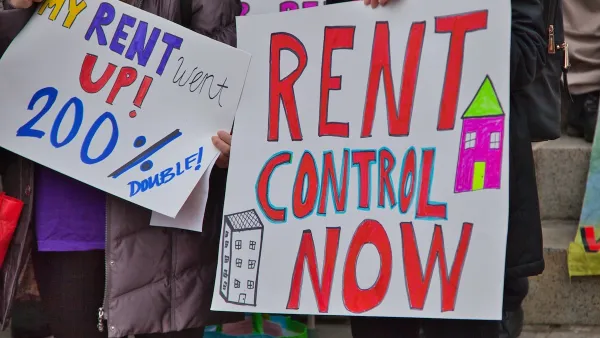With rental vacancy rates declining across America, the expansion of rent control policies may seem like a logical solution for protecting vulnerable renters from fast rising prices. But Peter Tatian argues there's little evidence that it works.
As cities across the U.S. search for solutions for the growing crisis in affordable housing, Tatian samples the research literature on the application of rent control and finds "very little evidence that rent control is a good policy."
"Arguments against rent control go back as far as the 1970s and the RAND housing allowance experiments in New York City. More recently, a MIT study of the 1995 repeal of rent control in Cambridge, Massachusetts, found that investment in housing increased after rent control ended, leading to “major gains in housing quality.” A National Bureau of Economic Research paper also examined the Cambridge experience and concluded that 'elimination of rent control added about $1.8 billion to the value of Cambridge’s housing stock between 1994 and 2004, equal to nearly a quarter of total Cambridge residential price appreciation in this period.'”
But what about more nuanced "rent stabilization" policies? In a comprehensive overview of the research literature, Blair Jenkins found that "rent stabilization doesn’t do a good job of protecting its intended beneficiaries—poor or vulnerable renters—because the targeting of the benefits is very haphazard," notes Tatian.
"Given the current research, there seems to be little one can say in favor of rent control," concludes Tatian. "What, then, should be done to help renters obtain affordable, decent housing? A better approach may be adopting policies that encourage the production of more diverse types of housing (different densities, tenure types, unit sizes, etc.), implementing strong regulations and practices to ensure housing quality and to protect tenants from abuses; and providing targeted, direct subsidies to people who need help paying their rents."
FULL STORY: Is Rent Control Good Policy?

National Parks Layoffs Will Cause Communities to Lose Billions
Thousands of essential park workers were laid off this week, just before the busy spring break season.

Retro-silient?: America’s First “Eco-burb,” The Woodlands Turns 50
A master-planned community north of Houston offers lessons on green infrastructure and resilient design, but falls short of its founder’s lofty affordability and walkability goals.

Delivering for America Plan Will Downgrade Mail Service in at Least 49.5 Percent of Zip Codes
Republican and Democrat lawmakers criticize the plan for its disproportionate negative impact on rural communities.

Test News Post 1
This is a summary

Test News Headline 46
Test for the image on the front page.

Balancing Bombs and Butterflies: How the National Guard Protects a Rare Species
The National Guard at Fort Indiantown Gap uses GIS technology and land management strategies to balance military training with conservation efforts, ensuring the survival of the rare eastern regal fritillary butterfly.
Urban Design for Planners 1: Software Tools
This six-course series explores essential urban design concepts using open source software and equips planners with the tools they need to participate fully in the urban design process.
Planning for Universal Design
Learn the tools for implementing Universal Design in planning regulations.
EMC Planning Group, Inc.
Planetizen
Planetizen
Mpact (formerly Rail~Volution)
Great Falls Development Authority, Inc.
HUDs Office of Policy Development and Research
NYU Wagner Graduate School of Public Service





























